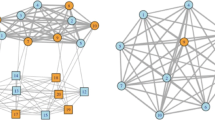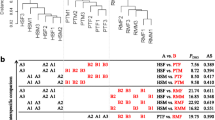Abstract
Microarrays are used in genetics and medicine to examine large numbers of genes simultaneously through their expression levels under any condition such as a disease of interest. The information from these experiments can be enriched by following the expression levels through time and biological replicates. The purpose of this study is to propose an algorithm which clusters the genes with respect to the similarities between their behaviors through time. The algorithm is also aimed at highlighting the genes which show different behaviors between the replicates and separating the constant genes that keep their baseline expression levels throughout the study. Finally, we aim to feature cluster validation techniques to suggest a sensible number of clusters when it is not known a priori. The illustrations show that the proposed algorithm in this study offers a fast approach to clustering the genes with respect to their behavior similarities, and also separates the constant genes and the genes with dissimilar replicates without any need for pre-processing. Moreover, it is also successful at suggesting the correct number of clusters when that is not known.















Similar content being viewed by others
References
Alonso, A., Berrendero, J., Hernandez, A., & Justel, A. (2006). Time series clustering based on forecast densities. Computational Statistics and Data Analysis, 51, 762–776.
Bar-Joseph, Z. (2004). Analyzing time series gene expression data. Bioinformatics, 20(16), 2493–2503.
Bar-Joseph, Z., Gerber, G. K., Gifford, D. K., Jaakkola, T. S., & Simon, I. (2003). Continuous representations of time-series gene expression data. Journal of Computational Biology, 10(3–4), 341–356.
Caiado, J., Crato, N., & Pena, D. (2006). A periodogram-based metric for time series classification. Computational Statistics and Data Analysis, 50, 2668–2684.
Celeux, G., Martin, O., & Lavergne, C. (2005). Mixture of linear mixed models for clustering gene expression profiles from repeated microarray experiments. Statistical Modelling, 5(3), 243–267.
Cho, R. J., Campbell, M. J., Winzeler, E. A., Steinmetz, L., Wodicka, A. C. L., Wolfsberg, T. G., et al. (1998). A genome-wide transcriptioanal analysis of the mitotic cell cycle. Molecular Cell, 2(1), 65–73.
Chu, S., DeRisi, J., Eisen, M., Mulholland, J., Botstein, D., & Brown, P. O. (1998). The transcriptional program of sporulation in budding yeast. Science, 282(5389), 699–705.
Corduas, M., & Piccolo, D. (2008). Time series clustering and classification by the autoregressive metric. Computational Statistics and Data Analysis, 52, 1860–1872.
Díaz, S. P., & Vilar, J. A. (2010). Comparing several parametric and nonparametric approaches to time series clustering: A simulation study. Journal of Classification, 27, 333–362.
Do, J. H., & Choi, D. (2008). Clustering approaches to identfying gene expression patterns from dna microarray data. Molecules and Cells, 25(2), 279.
Eisen, M. B., Spellman, P. T., Brown, P. O., & Boltstein, D. (1998). Cluster analysis and display of genome-wide expression patterns. Proceedings of the National Academy of Sciences, 95(25), 14,863–14,868.
Ernst, J., Nau, G. J., & Bar-Joseph, Z. (2005). Clustering short time series gene expression data. Bioinformatics, 21(suppl 1), i159–i168.
Galbraith, J., & Jiaqing, L. (1999). Cluster and discriminant analysis on time series as a research tool UTIP Working Paper Number 6, The University of Texas at Austin, Austin: Lyndon B
Hackstadt, A. J., & Hess, A. M. (2009). Filtering for increased power for microarray data analysis. BMC Bioinformatics, 10(1), 1.
Hakamada, K., Okamoto, M., & Hanai, T. (2006). Novel technique for preprocessing high dimensional time-course data from dna microarray: Mathematical model-based clustering. Bioinformatics, 22(7), 843–848.
Heard, N. A., Holmes, C. C., Stephens, D. A., Hand, D. J., & Dimopoulos, G. (2005). Bayesian coclustering of anopheles gene expression time series: Study of immune defense response to multiple experimental challenges. Proceedings of the National Academy of Sciences of the United States of America, 102(47), 16,939–16,944.
Heyer, L. J., Kruglyak, S., & Yooseph, S. (1999). Exploring expression data: Identification and analysis of coexpressed genes. Genome Research, 9(11), 1106–1115.
Irigoien, I., Vives, S., & Arenas, C. (2011). Microarray time course experiments: Finding profiles. IEEE/ACM Transactions on Computational Biology and Bioinformatics, 8(2), 464–475.
Kakizawa, Y., Shumway, R. H., & Taniguchi, M. (1998). Discrimation and clustering for multivariate time series. Journal of the American Statistical Association, 93, 328–340.
Khan, J., Simon, R., Bittner, M., Chen, Y., Leighton, S. B., Pohida, T., et al. (1998). Gene expression profiling of alveolar rhabdomyosarcoma with cdna microarrays. Cancer Research, 58(22), 5009–5013.
Kim, B. R., Zhang, L., Berg, A., Fan, J., & Wu, R. (2008). A computational approach to the functional clustering of periodic gene-expression profiles. Genetics, 180(2), 821–834.
Liao, T. W. (2005). Clustering of time series data: A survey. Pattern Recognition, 38(11), 1857–1874.
Luan, Y., & Li, H. (2004). Model-based methods for identifying periodically expressed genes based on time course microarray gene expression data. Bioinformatics, 20(3), 332–339.
Maulik, U., & Bandyopadhyay, S. (2002). Performance evaluation of some clustering algorithms and validity indices. IEEE Transactions on Pattern Analysis and Machine Intelligence, 24(12), 1650–1654.
McLachlan, G. J., Peel, D., Basford, K. E., & Adams, P. (1999). The emmix software for the fitting of mixture of normal and t-components. Journal of Statistical Software, 4(2), 1–14.
Möller-Levet, C. S., Klawonn, F., Cho, K. H., Yin, H., & Wolkenhauer, O. (2005). Clustering of unevenly sampled gene expression time-series data. Fuzzy Sets and Systems, 152(1), 49–66.
Ng, S. K., McLachlan, G. J., Wang, K., Jones, L. B. T., & Ng, S. W. (2006). A mixture of model with random effect components for clustering correlated gene-expression profiles. Bioinformatics, 22(14), 1745–1752.
Peddada, S., Harris, S., Zajd, J., & Harvey, E. (2005). Oriogen: Order restricted inference for ordered gene expression data. Bioinformatics, 21(20), 3933–3934.
Ramoni, M. F., Sebastiani, P., & Kohane, I. S. (2002). Cluster analysis of gene expression dynamics. Proceedings of the National Academy of Sciences, 99(14), 9121–9126.
Schliep, A., Schönhuth, A., & Steinhoff, C. (2003). Using hidden markov models to analyze gene expression time course data. Bioinformatics, 19(suppl 1), i255–i263.
Spellman, P. T., Sherlock, G., Zhang, M. Q., Iyer, V. R., Anders, K., Eisen, M. B., et al. (1998). Comprehensive identification of cell cycle-regulated of the yeast saccharomyces cerevisiae by microarray hybridization. Molecular Biology of the Cell, 9(12), 3273–3297.
Storey, J. D., Xiao, W., Leef, J. T., Tompkins, R. G., & Davis, R. W. (2005). Significance analysis of time course microarray experiments. Proceedings of the National Academy of Sciences of the America, 102(36), 12,837–12,842.
Szekely, G. J., & Rizzo, M. L. (2005). Hierarchical clustering via joint between-within distances: Extending ward’s minimum variance method. Journal of Classification, 22(2), 151–183.
Tamayo, P., Slonim, D., Mesirov, J., Zhu, Q., Kitareewan, S., Dmitrovsky, E., et al. (1999). Interpreting patterns of gene expression with self-organizing maps: Methods and application to hematopoietic differentiation. Proceedings of the National Academy of Sciences, 96(6), 2907–2912.
Vilar, J. A., Alonso, A., & Vilar, J. M. (2010). Non-linear time series clustering based on non-parametric forecast densities. Computational Statistics and Data Analysis, 54, 2850–2865.
Vilar, J. M., Vilar, J. A., & Pertega, S. (2009). Classifying time series data: A nonparametric approach. Journal of Classification, 26, 3–28.
Acknowledgements
The authors would like to thank the Academic Writing Center at Middle East Technical University for their writing consultation and editorial help.
Author information
Authors and Affiliations
Corresponding author
Appendix
Appendix
Irigoien et al. (2011) proposed a method to cluster the time-course gene expression levels. This procedure involves several steps, where the gene profiles are first standardized, and then the genes are filtered out if they have dissimilar replicates or constant patterns. The distances are measured with Procrustes statistics. The default Irigoien procedure is their methodology with Procrustes statistics. Furthermore, they embed their Procrustes statistics in k-means and compare this method with usual k-means algorithms with Euclidean and correlation distances.
ORIOGEN is a Java-based software package used to cluster time-course gene expression profiles (Peddada et al. 2005). ORIOGEN requires candidate gene profiles such as increasing or cyclical profiles. Next, each individual gene is tested against each profile by obtaining a goodness-of-fit statistic. According to the goodness-of-fit statistics each gene is assigned to one pattern which constitutes the clusters at the end of the algorithm.
EMMIX is another piece of software proposed by McLachlan et al. (1999) to fit a mixture model of multivariate normal or t-distributed components. This process is done with the Maximum Likelihood method and the optimum likelihood is obtained using an Expectation-Maximization (EM) algorithm. Two parameters for random effects and mixture effects can be used to specify the initial step of the EM algorithm. These two parameters can also be specified such that they can determine the clusters in which the subjects are assigned.
Rights and permissions
About this article
Cite this article
Cinar, O., Ilk, O. & Iyigun, C. Clustering of short time-course gene expression data with dissimilar replicates. Ann Oper Res 263, 405–428 (2018). https://doi.org/10.1007/s10479-017-2583-3
Published:
Issue Date:
DOI: https://doi.org/10.1007/s10479-017-2583-3




